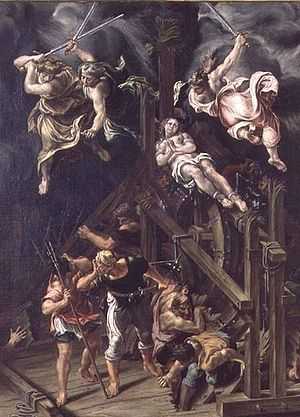Lelio Orsi (1508/1511 - 1587), also known as Lelio da Novellara, was a Mannerist painter and architect of the Reggio Emilia school in northern Italy.[1][2]
He was born and died in Novellara, and much of his work was completed in Reggio. He appears to have studied under such as Giovanni Giarola, a pupil of Antonio da Correggio. There is documentary evidence that he visited Rome in 1554-55, and may have been influenced by Girolamo Bedoli, Correggio and the prototypic mannerists Giulio Romano as well as Michelangelo and his successor Daniele da Volterra. He is said to have trained Raffaellino da Reggio. He was active in both exterior and interior decoration, and much of his work is in small cabinet pieces, not large altarpieces. Much of his output ended in the collections of the dukes of Este in Ferrara.
Orsi appears to be "reading" Correggio with the lens of Mannerist, the nocturnal, limned ethereal simplicity of Corregio here is constrained into contorted poses, perspective distorted, and settings crowded. The effect at times is unsettling. While the angels above unsheating divine swords are meant to carry the day, in The Martyrdom of Saint Catherine it appears that the execution was stymied by the breakdown of floors and gears.
Selected attributions
References
- Freedberg, Sydney J. (1993). Painting in Italy, 1500-1600. Penguin Books. pp. 577–679.
- Smyth, Francis P.; John P. O'Neill (Editors in chief) (1986). The Age of Correggio and the Carracci: Emilian Painting of the 16th and 17th Centuries. Washington DC: National Gallery of Art. pp. 150–158.
External links
| Persondata |
|---|
| Name |
Orsi, Lelio |
| Alternative names |
|
| Short description |
Italian painter |
| Date of birth |
1511 |
| Place of birth |
|
| Date of death |
1587 |
| Place of death |
|
